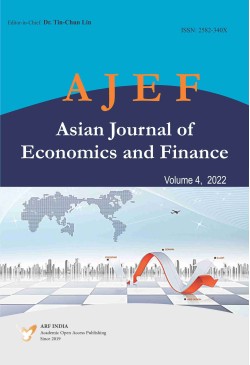
Asian Journal of Economics and Finance
Frequency :Quarterly
ISSN :2582-340X
Peer Reviewed Journal
Capital Asset Pricing Model (CAPM) is one of the most important developments in the finance literature. Capital Asset Pricing Model (CAPM) predicts the expected return on astock depends on its systematic risk as measured by its beta. This study is designed to examine theoretical and empirical validity of the CAPM on “BRVM”. For this study, monthly stock returns from 28 companies for the period January 1999 to December 2004 are chosen. Recent empirical evidence suggests that the relation between beta and realized returns is weak or event nonexistent. The traditional twostep procedure due to Fama and MacBeth (1973) used in most studies implies a test of two joint hypotheses. The hypothesis that there is a positive relationship between beta and realized return is tested jointly with the hypothesis that the average market risk premium is positive. The result of this analysis show that the intercept terms are not significantly different from zero and reject the linear relationship between expected returns and their systematic risk, thus rejecting the validity of the CAPM on RSES.
Keywords: Stock, expected return, CAPM, RSES, systematic risk.
The article examines the different paths taken by China and the former USSR to reform their economies from a centrally planned to a market economy. China embarked on a “Gradualist Policy” of trial and error to reform their economy while the USSR adopted the “Big Bang” approach. The results speak for themselves as China’s economy increased fourfold between 1990 and 2000 whereas Russia’s economy contracted by some 60 percent. Many of the Central and East European Economies who followed Russia in the Big Bang approach experienced the same dismal result. Today these countries including China have large segments of their economy marketised but nevertheless they still have the same problems of corporate governance
Over the past three decades, international remittances inflows have emerged as a significant and stable source of financial inflows and growth promotion for many developing countries. To better understand remittances economic growth nexus, the current study seeks to analyze the long run relationship between FDI, Openness, Domestic Investment and Economic growth in some selected Sub Saharan African countries namely: Nigeria, Ghana, Kenya and Senegal using annual panel data for the period of 19802017 and employed econometrics analytical techniques including descriptive statistics and matrix correlation of variables and LLC and IPS unit root test and Pedroni, From the longrun cointegrating parameter estimates of FMOLS and DOLS, results opined that an increase in remittances, foreign direct investment trade openness and domestic investment, increases economic growth of SSA countries proxied by GDP.Therefore the study recommends that there is the need for SubSaharan African countries to design policies, programs as well as the institutional reform that will encourage the productive use of remittances.
Keywords: Economic Growth, remittances, FDI, Domestic Investment, Trade openness and FMOL
Passthrough of policy rate to deposit and lending rates of banks is a prerequisite for effective monetary policy transmission, which becomes even more important in an economy like India where banks are predominant financial intermediaries. This paper finds a stable longrun relationship between policy repo rate and bank deposit/lending rates. The passthrough of policy rate to bank rates is incomplete and asymmetric; the asymmetry, however, has reduced over the years. The longterm impact of a 100 basis points change in policy rate on bank deposit/lending rates is 70/65 basis points with the shortterm impact being lower around 60 basis points during 20062019.
Keywords: Monetary transmission, passthrough ofpolicy rate, bank lending rate, threshold autoregressive model.
JEL classification: C31, E43, G21.
In the present study we develop a utility maximization process with budget delegation to examine the interactions between corruption, fiscal performance and political institutional factors. Our empirical findings for Greece over the period 19842018 show that a fiscal reform to improve the quality of the corruption detection mechanism and of the budget institutional framework, would yield important fiscal benefits. The funding of the corruption detection services affects the expected fiscal deficit through the channel of the audits. Ideology is a central factor to determine the probability of corruption detection. A stronger government and a more stable political system with less fragmentation signal a commitment to confront with the pressure of the interest groups, thus leading to a higher effectiveness of the government’s auditing mechanisms.
Keywords: Fiscal governance, Corruption, Budget institutions, Political system, Utility maximization.
JEL Classification: D73, E62, H61